December 2013
Grumman
Martlet Mk.I
Type
XXVII Seehund mini-sub
|
December 2013 |
||
![]()
![]() Selected
WW2 70th Anniversaries this month:
Selected
WW2 70th Anniversaries this month:
Between 2009 and 2015, I have set myself a general modelling theme based on selected 70th Anniversaries from WW2.
|
Throughout the month Allied bombers pound occupied Europe, the USAAF by day and the RAF by night. Berlin is made a special target. 2 Dec 1943 - A massive air-raid on Bari Harbour Italy by 105 Ju88 bombers sinks 28 ships and places the harbour, a major Allied disembarkation port, out of use for nearly a year. The raid results in the explosion of American merchant ship the SS John Harvey, which is carrying a secret cargo of Mustard Gas; this is released over the town and into the sea. Within a day over 800 military and civilian casualties present with unexplained acute symptoms including blindness and chemical burns. 12 Dec - Field Marshall Erwin Rommel is appointed in command of "Fortress Europa", chief planner against the expected Allied invasion of mainland Europe. 14 Dec - Units of the US VII and XV Corps begin to arrive in the UK to prepare for the coming invasion. 16 Dec - The Red Army recaptures the Baltic port of Kalinin after a fierce offensive. 24 Dec - US General Dwight D Eisenhower is appointed Supreme Allied Commander Europe and establishes his HQ in London. 25 Dec - Battle of the North Cape - The Battlecruiser Scharnhorst sorties from her Norwegian lair under the cover of darkness to try and disrupt Arctic convoy JW 55B off the North Cape. At daybreak on the 26th she is met by a determined force of radar equipped Royal Navy, Canadian and Norwegian Cruisers and Destroyers, led by the Battleship HMS Duke of York. At 1650, Duke of York fires the first salvo. By 1945 the Scharnhorst has received multiple gun and torpedo hits and cannot survive. She sinks quickly by the bows, with propellers still turning. Of her crew of 1,968 officers and enlisted men, only 36 survive the icy waters in the mid-winter darkness. "Gentlemen, the battle against the Scharnhorst has ended in victory for us. I hope that any of you who are ever called upon to lead a ship into action against an opponent many times superior will command your ship as gallantly as the Scharnhorst was commanded today." Admiral Sir Bruce Fraser RN, CinC Home Fleet |
Fleet Air Arm Museum (restoration) 2013.
Hobbyboss,
1/72 with own decals.
After last month's excellent Yeovilton modelling show saw my stand right in front of the newly revealed Martlet, what else could I do this month, but add the missing mark to my existing flock of Martlets.............
AL246 is the last surviving example from a batch of 81 American made Grumman G-36A fighter planes ordered by France in early 1940.
After the fall of France in May 1940, this contract was hastily transferred to Britain and the aircraft arrived for use by the Royal Navy in November 1940. By the end of the war only a few of the batch remained and by 1946 AL246 was the only known survivor. AL246 ended up at the Aircraft Training School at Loughborough, Leicestershire sometime around 1943/44, a move which aided its survival. Here it remained until the late 1950’s when it was transferred to the Air Training School here at Yeovilton.
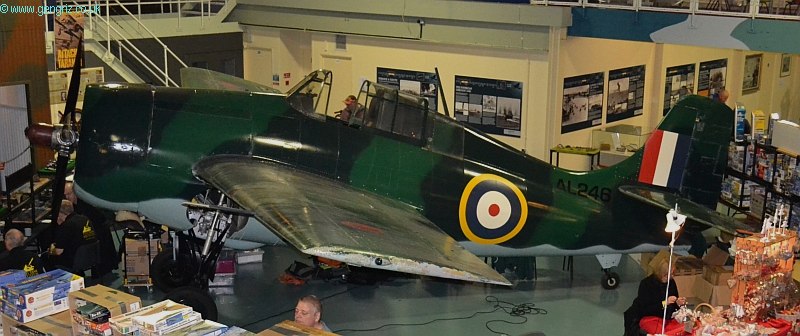
AL246 as it appears in 2013
In 1964 it was presented to the Fleet Air Arm Museum and has been on permanent display ever since in an overall blue scheme that had been applied in the 1960s. Since 2007 the museum has been undertaking a restoration programme similar to that applied to their Corsair KD431. This has involved the painstaking inch by inch removal of each paint finish applied since leaving the Grumman factory in 1940.
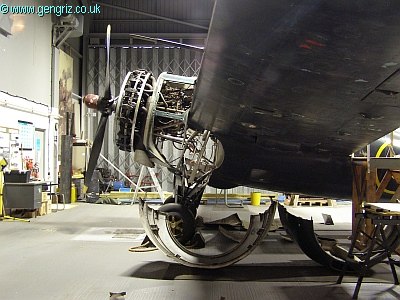
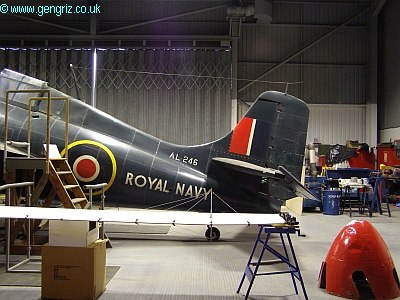
AL246 begins its restoration in 2007
The aircraft had been over painted several times between 1940 and 1964 for various reasons and all references to the very unusual original colour scheme had seemingly been lost. Only a few photographs of these aircraft exist from the 1940’s and due to colour variations in image processing, historians and modellers have not been able to agree exactly which colours were used to paint these aircraft.
The wings, tail plane, rudder and a few small panels still retained their original Grumman factory finish beneath the later over painted layers, and after 6 years of skilled detail conservation work the team have revealed and preserved these original and unique painted areas.
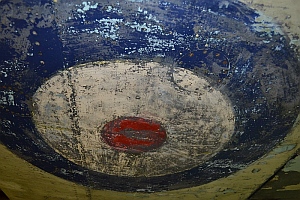
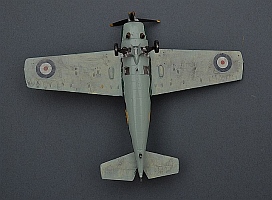
The underwing areas show the original roundel and a mix of light blue with normal sky applied on top.
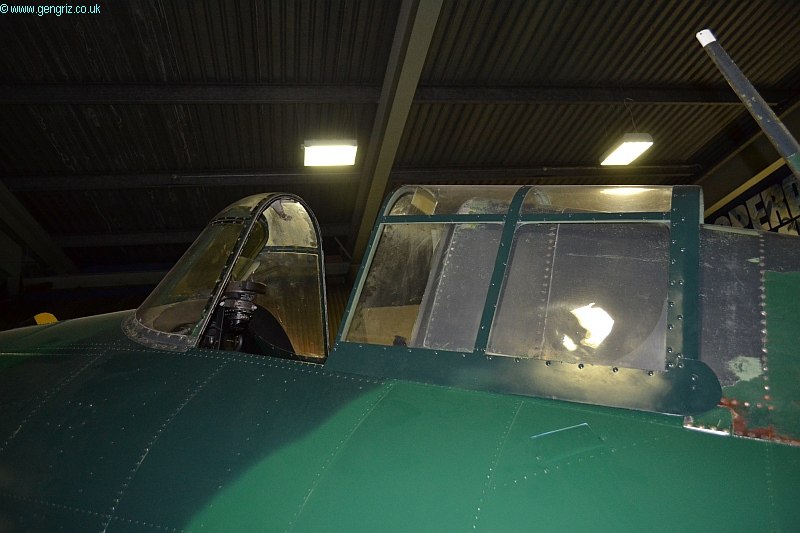
Sadly, the fuselage section had been stripped to bare metal prior to 1964 and so the team have recreated this missing portion with a newly painted and carefully colour-matched finish

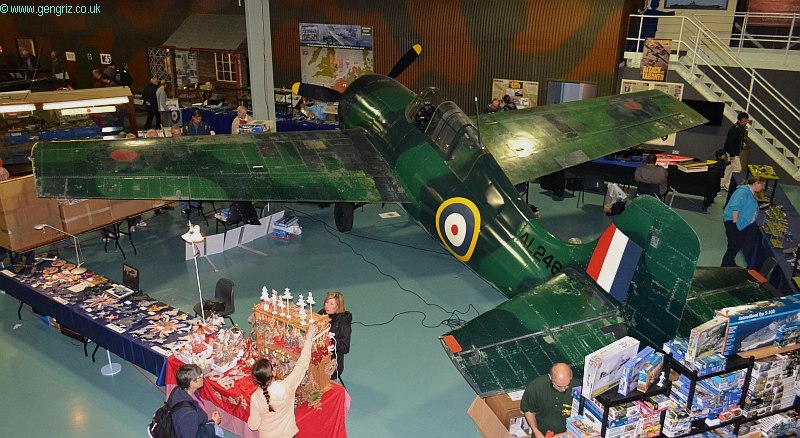
The real aircraft today at the Fleet Air Arm Museum, RNAS Yeovilton
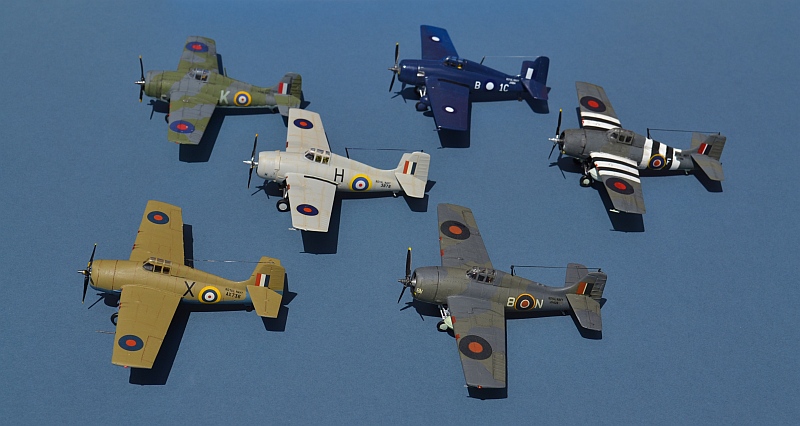
The rest of my Martlet Flock - piccies with the new arrival will follow!
Link to other WW2 Fleet Air Arm aircraft on my RN Props Pages
North Sea, 1944
Revell, 1/72.
The Type XXVII Seehund (German for seal), was a successful series of midget submarines created during World War II. Designed in 1944, and operated by two man crews, the submarines were used by the Kriegsmarine during the closing months of the war, sinking 9 merchant vessels and damaging an additional 3, with 35 losses mostly attributed to bad weather.
The Seehund was inspired by the daring British X-Craft attacks on the Tirpitz (Operation Source, September 1943) , but instead of explosive charges, the German design carried two G7e homing torpedoes for operation in coastal areas and on the open sea. A total of 285 Seehunds were built, with the last wartime Seehund sorties on 28 April and 2 May 1945, when two special missions were used to resupply the surrounded German garrison at Dunkirk by carrying special food containers (nicknamed "butter torpedoes") instead of torpedoes, and on the return voyage using the containers to carry mail from the Dunkirk garrison.
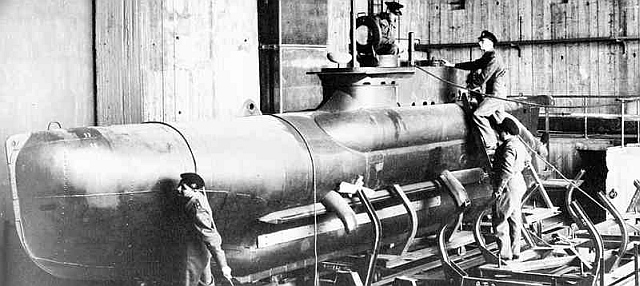
British Officers inspect a captured Seehund
The French navy received four units as war reparations, and commissioned them as S 621, S 622, S 623 and S624. They were used until August 1953. S 622 is preserved and on display at Brest naval museum.
I've wanted to build one of these for a while (although I would prefer an X-Craft!). Originally produced by ICM, Revell have recently issued this kit and last month, Wonderland Models in Edinburgh had it at a very much reduced price.
By amazing co-incidence on of the distractions affecting my modelling in September and October was my participation in a large international sailing championship based out of Brest, where to my delight I saw French SSNs, NH-90 Caiman helicopters and all manner of French Navy surface ships each day.
The final prizegiving for our event took place in Brest Castle (Chateuau?), within the superb Marine National Museum, where one of the only remaining Seehunds sits. And I missed it. Goodness knows how - I must have been standing within a few yards of it (with a camera!), although to be fair it was very dark in the museum grounds and I was probably rather over-enjoying the French hospitality!
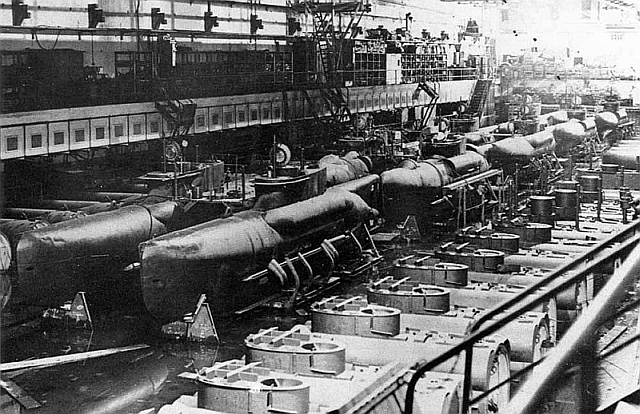
Seehunds under construction toward the end of the war
Link to more Nautical Vessels on my Wet Side Pages
And finally........... So that's the end of my modelling year yet again. 2013 has seen a lot of distractions, but the modelling has continued unabated, the stash has continued to grow and long may it do so. Building this year's additions to my collection has given me a lot of fun (and has de-stressed me very effectively when needed!). I hope that you have enjoyed sharing them with me and hope to see some of you around the bazaars next year!
Link to previous month Link to Next Month
www.gengriz.co.uk
Background Image: Newly revealed original underwing roundel on the Fleet Air Arm Museum's Grumman Martlet